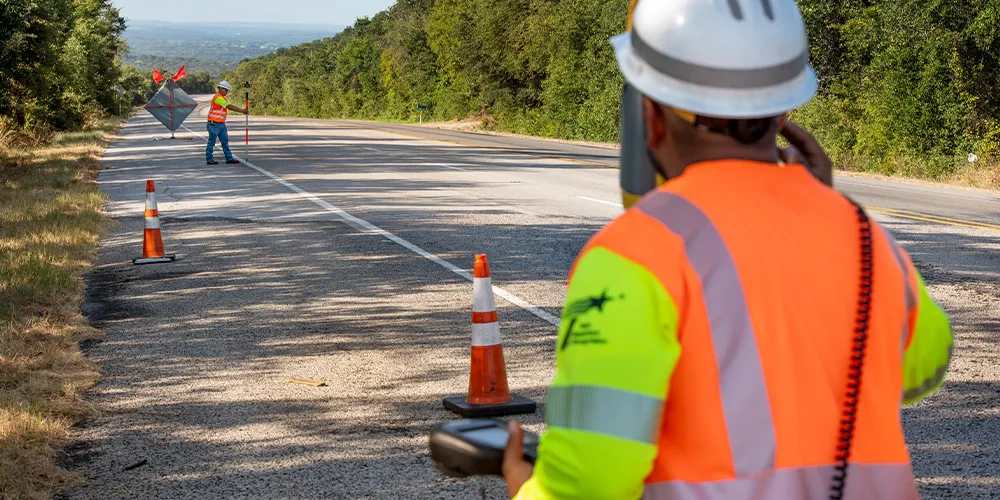Señales de tráfico y señales

Cuando TxDOT recibe una solicitud para una nueva señal de tráfico en el sistema de carreteras estatales, la oficina del distrito local realiza un estudio de ingeniería y tráfico de la ubicación propuesta. Para justificar una nueva señal, las condiciones del tráfico deben cumplir con al menos uno de los nueve estándares mínimos, también conocidos como "warrants". La Parte 4C del Manual de Texas sobre Dispositivos Uniformes de Control de Tráfico (TMUTCD) especifica estas órdenes, que se basan en las pautas establecidas por TxDOT y la Administración Federal de Carreteras.
Los ingenieros de tráfico determinan si una señal es la forma adecuada de controlar el tráfico evaluando cuidadosamente la cantidad de vehículos y peatones que usan la intersección. También consideran el diseño de la intersección, el desarrollo en el área, los retrasos experimentados por los automovilistas durante las horas pico, las velocidades promedio de los vehículos, los planes futuros de construcción de carreteras y la cantidad y tipos de accidentes de tráfico registrados.
Ejemplos de información utilizada por los ingenieros de tráfico para evaluar las solicitudes de señales de tráfico incluyen:
- Cantidad de tráfico en calles principales y secundarias.
- Actividad peatonal.
- Número de escolares que cruzan el sitio.
- Historial de fallas del sitio.
- Retraso en el flujo de tráfico existente.
- Velocidad del tráfico que se aproxima a la intersección.
- Tamaño de la comunidad.
Una evaluación de semáforos puede ayudar a evaluar si un semáforo nuevo es la respuesta correcta para un lugar concreto. En algunos casos, una nueva señal de tráfico no es la solución. Cuando una señal de tráfico no está justificada debido a las condiciones actuales, la señal propuesta puede reducir el número de choques en ángulo recto, pero en realidad puede aumentar el número total de choques, particularmente colisiones traseras.
TxDOT tiene 25 oficinas de distrito ubicadas en todo el estado para atender sus necesidades de transporte local. Puede realizar una solicitud de semáforo comunicándose con laoficina de distritolocal de su área en particular. El personal de nuestra oficina de distrito también puede ayudarlo a determinar qué jurisdicción es responsable de una ubicación específica.
Cada oficina de distrito de TxDOT está dirigida por un ingeniero de distrito. Esta persona tiene la autoridad para aprobar una nueva señal de tráfico en espera de hallazgos satisfactorios del estudio y evaluación del ingeniero de tráfico del distrito.
Las ciudades y los condados suelen ser responsables de las señales de tráfico en las calles de la ciudad y las carreteras del condado. Los gobiernos locales comparten responsabilidades con TxDOT con respecto a las carreteras estatales cuando la población de una ciudad supera los 50,000 habitantes. Esto incluye los costos de desarrollo, instalación y operación de señales de tráfico.
Cuando las carreteras se cruzan con el sistema de carreteras estatales, TxDOT se encarga de la instalación, operación y mantenimiento de las señales de tráfico. Nuestros empleados del distrito trabajan arduamente para evaluar todas las solicitudes de luces de señalización.
Varios factores afectan el tiempo que lleva instalar una señal de tráfico, como la necesidad de coordinación de la ciudad o el condado, la preparación de planes de ingeniería y la complejidad de las adjudicaciones e instalaciones de contratos. Si los planes avanzan sin problemas y hay fondos disponibles, se podría instalar una señal de tráfico aprobada en uno o dos años.
Las solicitudes de señales de tráfico a veces se niegan porque la ubicación no cumple con al menos una de las nueve órdenes especificadas en el TMUTCD. En algunos casos, incluso si una ubicación satisface una o más de las órdenes requeridas, es posible que la solicitud no sea aprobada, porque podría ser más un peligro que una ayuda. Por ejemplo, si se solicita una señal de tráfico cerca de una curva cerrada con una vista limitada de la intersección, una instalación de señales en ese lugar puede aumentar la ocurrencia de choques de vehículos, en lugar de reducirlos.
Otras razones para la desaprobación pueden basarse en el juicio del ingeniero de tráfico de que un método de control de tráfico alternativo es más adecuado para la ubicación que una nueva señal. Esto podría incluir solicitar una mayor presencia policial en el lugar, mejorar la visibilidad y la conciencia pública de la intersección, mejorar las marcas en el pavimento en la ubicación de la carretera o instalar luces de advertencia intermitentes o señales adicionales.
Los ingenieros de tráfico de TxDOT también considerarán la posibilidad de que la colocación de una señal innecesaria pueda tener otros impactos indeseables, como demoras excesivas e innecesarias, desprecio público de la señal y desvío del tráfico a rutas menos deseables para evitar la señal.
TxDOT es responsable de construir y mantener el sistema de carreteras estatales. No tenemos autoridad para citar infracciones de vehículos de ningún tipo. Esa jurisdicción recae bajo el Departamento de Seguridad Pública de Texas y las autoridades locales de aplicación de la ley.